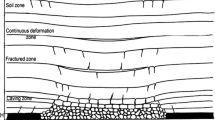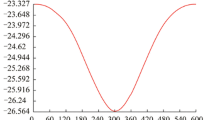Abstract
A substantial number of the coal mines in China are in the geological condition of thick alluvium layer. Under these circumstances, it does not make sense to predict ground surface subsidence and other deformations by using conventional prediction models. This paper presents a novel ground surface subsidence prediction model for sub-critical mining in the geological condition of thick alluvium layer. The geological composition and mechanical properties of thick alluvium is regarded as a random medium, as are the uniformly distributed loads on rock mass; however, the overburden of the rock mass in the bending zone is looked upon as a hard stratum controlling the ground surface subsidence. The different subsidence and displacement mechanisms for the rock mass and the thick alluvium layer are respectively considered and described in this model, which indicates satisfactory performances in a practical prediction case.
Similar content being viewed by others
References
Álvarez-Fernández M I, González-Nicieza C, Menéndez-Díaz A, Álvarez-Vigil A E (2005). Generalization of the n-k influence function to predict mining subsidence. Eng Geol, 80(1–2): 1–36
Awershen C R (1959). Rock Movement due to Underground Mining in Coal Mine. Beijing: Coal Industry Press, 24–32 (in Chinese)
Bai M, Kendorski F, Van Roosendaal D (1995). Chinese and North American high-extraction underground coal mining strata behavior and water protection experience and guidelines. Proceedings of the 14th International Conference on Ground Control in Mining, Morgantown, 209–217
Baxevanis Th, Plexousakis M (2009). Estimation of base settlement from the surface subsidence profile: two-Dimensional plain field of displacements. Int J Numer Anal Methods Geomech, 33(8): 1109–1121
Berry D S (1960). An elastic treatment of ground movement due to mining — I. Isotropic ground. J Mech Phys Solids, 8(4): 280–292
Boreek M, Chudek M (1985). Rock Mass Mechanics in Mining. Beijing: Coal Industry Press (in Chinese)
Chang Z Q, Wang J Z (2003). The space problems research under thick loose layer bend sinking. Journal Mine Surveying, 9: 36–38 (in Chinese)
Corlett A V, Emery C L (1959). Prestress and stress redistribution in rocks around a mine opening. Bull Can Min Metall., 372-383
Cui X M, Miao X X, Wang J A, Yang S, Liu H, Song Y, Liu H, Hu X (2000). Improved prediction of differential subsidence caused by underground mining. Int J Rock Mech Min Sci, 37(4): 615–627
Dai H Y, Wang J Z, Cai M F (2002). Seam dip angle based mining subsidence model and its application. Int J Rock Mech Min Sci, 39(1): 115–123
Du S G, Weng X H (1997). Relationship between dip angle of coal seam and heights of Three Zones. Journal of Engineering Geology, 5(3): 211–217 (in Chinese)
Evans W H (1941). The strength of undermined strata. Trans Inst Min Metall, 50: 475–500
Fairhurst C (2003). Stress estimation in rock: a brief history and review. Int J Rock Mech Min Sci, 40(7–8): 957–973
He G Q, Yang L; Research on Mine Subsidence (1991). Xuzhou: China University of Mining Technology Press (in Chinese)
Jacobi O (1966). The increase of roof flaking in long-wall faces as a result of working under pillar edges and of abutment pressure of adjacent workings. Int J Rock Mech Min Sci Geomech Abstr, 3(3): 221–230
Knothe S (1957). Observations of surface movements and their theoretical interpretation, Proceedings of the European congresson ground movement, University of Leeds, UK, 210–215
Kratzsch H (1983). Mining Subsidence Engineering. Berlin: Springer-Verlag
Kulakov G S (1975). The stress distribution in the abutment pressure zone according to the results of field measurements. Int J Rock Mech Min Sci Geomech Abstr, 12(10): 231–234
Lai X P, Cai M F, Ren F H, Xie M W, Esaki T (2006). Assessment of rock mass characteristics and the excavation disturbed zone in the Lingxin Coal Mine beneath the Xitian river, China. Int J Rock Mech Min Sci, 43(4): 572–581
Li G, Mizuta Y, Ishida T, Li H, Nakama S, Sato T (2009). Stress field determination from local stress measurements by numerical modeling. Int J Rock Mech Min Sci, 46(1): 138–147
Li W X, Liang X L, Zhao S T, Mei S H (2006). The elastic-thin-plate bending method for predicting ground subsidence due to underground mining. Engineering Mechanics., 23(8): 177–181 (in Chinese)
Liao C P (1993). Fuzzy infuence function method for calculating mine subsidence in a horizontal seam. Geotech Geol Eng, 11(4): 235–247
Lin S, Reddish D J, Whittaker B N (1992). An integrated analytical model of subsidence induced by level seam extractions. Geotech Geol Eng, 10(3): 203–221
Lin YM (1984). Simulation Research on Experimental Rock Mechanics. Beijing: Coal Industry Press (in Chinese)
Litwiniszyn J (1957). The theories and model research of movements of ground masses. Proceedings of the European Congress on Ground Movement, University of Leeds, 206–209
Litwiniszyn J (1974). Stochastic Methods in the Mechanics of Granular Bodies. Wien: Springer-Verlag
Liu B S, Liao G H (1965). Basic Law Governing Ground Movement in Coal Mines. Beijing: Coal Industry Press, 55–60 (in Chinese)
Ma D (2001). Discussions about the relations of three-dimension elastic theory, classical thin plate theory and thick-walled construction theory. Journal of Liaoning Institute of Technology, 21(1): 48–50 (in Chinese)
Mining Institute of China (1981). Rock Strata and Ground Surface Displacement in Coal Mines, Beijing: Coal Industrial press (in Chinese)
Mohammad N, Reddish D J, Stace L R (1997). The relation between in situ and laboratory rock properties used in numerical modelling. Int J Rock Mech Min Sci, 34(2): 289–297
National Coal Board Mining Department (1975). UK Subsidence Engineer’s Handbook, NCB Mining Department, London
Oravecz K I (1986). Improved prediction of surface subsidence using the influence function approach. In: Sangorm Symposium: The Effect of Underground Mining on Surface, 73–80
Panek, L A (1964). Design of bolting systems to reinforce bedded mine roof. U.S. Bureau of Mines Report of Investigations 5155, 16
Peng S S, Chiang H S (1984). Long Wall Mining, New York: Wiley, 707–708
Reddy J N (2006). Theory and Analysis of Elastic Plates and Shells (2nd edition). Boca Raton: CRC Press
Ren G, Reddish D J, Whittaker B N, Whittaker B N (1987) Mining subsidence and displacement prediction using influence function methods. Min Sci Technol, 5(1): 89–104
Salamon M D G (1963). Elastic analysis of displacements and stresses induced by the mining of seam or reef deposits-Part 1. Fundamental principles and basic solutions as derived from idealized models. J S Afr Inst Min Metall, 64: 128–149
Sansone E C, Ayres Da Silva L A (1998). Numerical modeling of the pressure arch in underground mines. Int J Rock Mech Min Sci, 35(4–5): 436
Sheorey P R (1994). A theory for in situ stresses in isotropic and transversely isotropic rock. Int J Rock Mech Min Sci Geomech Abstr, 31(1): 23–34
Sheorey P R, Lou J P, Singh K B, Singh S K (2000). Ground subsidence observations and a modified influence function method for complete subsidence prediction. Int J Rock Mech Min Sci, 37(5): 801–818
Su Z J, Liu W S, Yang L (2003). A mechanical model of subsidence due to mining and its application. Mech Eng, 25(2): 45–47
Timoshenko S, Woinowsky-Krieger S (1959). Theory of Plates and Shells. New York: Mcgraw-Hill Book Company, Inc.
Wang C G, Song Z Q, Shi Y K (2004). Study on the relation between stratum movement and subsidence of flat seam mining. Rock and Soil Mechanics, 25(8): 1343–1346 (in Chinese)
Wang J A, Shang X C, Ma H T (2008). Investigation of catastrophic ground collapse in Xingtai gypsum mines in China. Int J Rock Mech Min Sci, 45(8): 1480–1499
Wang J Z, Li Y S, Zhou X (1997). Ground movement caused by mining under thick alluvium. Journal of China Coal Society, 22(1): 90–93 (in Chinese)
Wang J Z, Wu L X (1995). Study of strata and surface movement and mining under village houses in the mountainous area in Furong coal field. Journal of China University of Mining and technology, 24(2): 52–58 (in Chinese)
Wright F D (1973). Roof control through beam action and arching. In: Cummins A B, Given I A, eds. SME Mining Engineering Handbook, New York: Society of Mining Engineers, 13: 80–96
Wu L X, Qian M G, Wang J Z (1997). The influence of a thick hard rock stratum on underground mining subsidence. Int J Rock Mech Min Sci, 34(2): 341–344
Wu L X, Wang J Z (1994). Study of deformation model of a controlling holding plate when large area is extracted continuously. Journal of China Coal Society, 19(3): 233–242 (in Chinese)
Xie H P, Chen Z H, Wang J C (1999). Three-dimensional numerical analysis of deformation and failure during top coal caving. Int J Rock Mech Min Sci, 36(5): 651–658
Xu Z L (1992). Mechanics of Elasticity (II). 3rd edition. Beijing: Higher Education Press (in Chinese)
Yang L (1988). The new knowledge about the mechanism and the law of displacement in rock and ground due to coal mining. Journal of Fuxin Mining Institute, 7(1): 9–18 (in Chinese)
Yavuz H (2004). An estimation method for cover pressure re-establishment distance and pressure distribution in the goaf of long wall coal mines. Int J Rock Mech Min Sci, 41(2): 193–205
Zhang J C, Shen B H (2004). Coal mining under aquifers in China: a case study. Int J Rock Mech Min Sci, 41(4): 629–639
Zhang X D, Zhao Y H, Liu S J (1999). A new method of calculating surface subsidence and deformations under thick alluvial soil. Chinese Journal of Nonferrous Metals, 9(2): 435–440 (in Chinese)
Author information
Authors and Affiliations
Corresponding author
Additional information
Zhanqiang CHANG received his Ph.D and Master’s degrees in Geodesy and Survey Engineering from China University of Mining Science and Technology (Beijing) respectively in 1990 and 2004. He received his Bachelor degree from Shandong Mining Institute in 1984. He is currently in School of Resources, Environment and Tourism, Capital Normal University of China. His research interests include ground subsidence prediction as well as monitoring ground subsidence by remote sensing technique. He has published more than 40 research papers in Chinese and international journals. In 2009, he worked in the Geotechnical Engineering Department of Civil Engineering, University of Minnesota, Duluth as a visiting scholar with Dr. Carlos Carranza-Torres.
Jingzhuang WANG received his Master’s degree from Donetsk University, the former Soviet Union in 1959. He is currently with the Institute of Earth Sciences and Mapping, China University of Mining and Technology (Beijing). He served as the deputy director of coal mining damage technology appraisal committee of China Coal Society. His research interests include mining subsidence and prevention, mining subsidence control theory and technology, and modern surveying technology and applications. He has published more than 300 research papers in Chinese and international journals.
Mi CHEN received her Ph.D in photogrammetry and remote sensing from Wuhan University, Wuhan, China, in 2006. She is currently a Lecturer with the School of Resources, Environment and Tourism, Capital Normal University. Her current research interests include regional land subsidence monitoring and InSAR technique applications.
Zurui AO received his Bachelor’s degree from Henan Polytechnic University in 2011. His research interests include the theory and application of remote sensing. He is currently in the Master’s degree program at the School of Resources, Environment and Tourism, Capital Normal University, China.
Qi YAO received his Bachelor’s degree from Capital Normal University in 2012. His research interests include land subsidence monitoring and forestry remote sensing. He will graduate from Capital Normal University in 2015 with his Master’s degree.
Rights and permissions
About this article
Cite this article
Chang, Z., Wang, J., Chen, M. et al. A novel ground surface subsidence prediction model for sub-critical mining in the geological condition of a thick alluvium layer. Front. Earth Sci. 9, 330–341 (2015). https://doi.org/10.1007/s11707-014-0467-2
Received:
Accepted:
Published:
Issue Date:
DOI: https://doi.org/10.1007/s11707-014-0467-2




